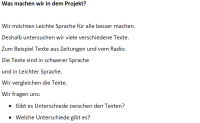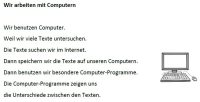Information density and linguistic encoding in “Leichte Sprache“ (IDeaLite)
Project T1 Transfer Project
This transfer project applies insights gained from the study of the way information is linguistically encoded in CRC 1102 “Information Density and Linguistic Encoding” to the analysis and evaluation of texts in LEICHTE SPRACHE (Easy German), which is an umbrella term for different forms of regulated German that have been created to make written information accessible for low-literacy readers (Netzwerk Leichte Sprache, 2014; Bredel and Maaß, 2016; Bock, 2018b). LEICHTE SPRACHE is high on the political agenda and a core measure in creating equal opportunities. Providing information in Easy German alongside Standard German is requested from public institutions (cf. Bundesteilhabegesetz und Nationaler Aktionsplan 2.0) and increasingly provided also by organizations in the social sector.
Specifically, we pursue the following goals: (1) to show that the models of information density we have developed in the course of CRC 1102 are suitable to assess texts in terms of fit for specific user groups (here, people with low literacy due to learning difficulties); (2) to extend existing surprisal-based models by integrating additional linguistic phenomena relevant in the context of Easy German (especially text cohesion and coherence) and (3) to engage with users and providers of Easy German eliciting their expert insights and judgment and, in turn, to give them linguistically informed input and practical advice on user group–tailored text production. In terms of methods, we pursue a corpus-based approach combined with selected experiments. To explore Easy German, we compare corpora of Standard Language
and Easy German in selected domains (e.g. newspaper text, institutional websites) and apply selected information-theoretic measures, such as surprisal of words and syntactic patterns, the entropy over lexical usage (cf. previous work by project B1/Teich) and the information density of sentences (cf. previous work by B3/Reich). Judgment tasks of text variants independently assumed to be “easy” vs. “standard” and simple completion tasks that involve users of Easy German are carried out to obtain complementary evidence from individuals in real-time interaction.
The research relies on close collaboration with external partners: Arbeiterwohlfahrt (AWO) Saarland and Netzwerk Leichte Sprache with AWO Dillingen/Saarlouis as our official application partner, as well as Heike Zinsmeister as an external academic PL who brings in specific expertise on corpus-based analysis of Easy German and will liaise with Netzwerk Leichte Sprache.
Keywords: easy German











Die Wissenschaftler und Wissenschaftlerinnen von der Universität des Saarlandes
und von der Universität Hamburg haben den Text in Leichter Sprache geschrieben.
Die Prüf-Gruppe von der AWO Teilhabe in Dillingen hat den Text geprüft.
Wir sind Mitglied im Netzwerk Leichte Sprache.
Die Bilder sind von:
© Lebenshilfe für Menschen mit geistiger Behinderung Bremen e.V.
Der Zeichner ist Stefan Albers, Atelier Fleetinsel, 2013.
Das Europäische Zeichen für Leichte Sprache:
© European Easy-to-Read Logo: Inclusion Europe.
Mehr Informationen unter: www.inclusion-europe.eu/easy-to-read
Der Text in der Tabelle ist von der Internet-Seite vom NDR.
Den ganzen Text können Sie hier lesen:
Wir haben den Link am 1. Februar 2022 überprüft.
Publications T1
Other Area-C Projects
- Information Density and the Predictability of Phonetic Structure C1
- Rational Encoding and Decoding of Referring Expressions C3
- Mutual Intelligibility and Surprisal in Slavic Intercomprehension (INCOMSLAV-3) C4
- Information Management as a Factor for Syntactic Variation in the History of German C6
- Cross-linguistic Information-Theoretic Modelling of Communicative Efficiency C7